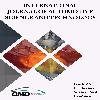Modelling A Single-Rotor Wankel Engine Performance With Artificial Neural Network At Middle Speed Range
The researches on Wankel engines are very rare and considered new in modelling and prediction. Therefore this study deals with the artificial neural network (ANN) modelling of a Wankel engine to predict the power, volumetric efficiency and emissions, including nitrogen oxide, carbon dioxide, carbon monoxide and oxygen by using the change of mean effective pressure, intake manifold pressure, start of ignition angle and injection duration as inputs. The experiment results were taken from a research which is performed on a single-rotor, four stroke and port fuel injection 13B Wankel engine. The number of datas which are taken from experimental results were scarce and varied in six different data set (for example; mean effective pressure, from 1 to 6 bar) at 3000 rpm engine speed. The standard back-propagation (BPNN) Levenberg-Marquardt neural network algorithm is applied to evaluate the performance of middle speed range Wankel engine. The model performance was validated by comparing the prediction data sets with the measured experimental data. Results approved that the artificial neural network (ANN) model provided good agreement with the experimental data with good accuracy while the correlation coefficient R varies between 0.79 and 0.97.
Keywords:
Artificial neural network, Engine performance, Exhaust emissions, Scarce data, Wankel engine,
___
- Cihan, O. (2017). Wankel motoru ve cevrim atlatma sisteminin deneysel ve sayısal olarak incelenmesi. Doktora Tezi, Istanbul Teknik Üniversitesi, Fen Bilimleri Enstitüsü, Türkiye.
- Kutlar, A. and Malkaz, F. (2019). Two-stroke Wankel type rotary engine: a new approach for higher power density energies. Energies, 12, 1-22.
- Malkaz, F. (2011). Iki zamanlı Wankel tipi döner pistonlu motorun analizi. Yüksek Lisans tezi, İstanbul Teknik Üniversitesi, Fen Bilimleri Enstitüsü, Türkiye.
- Cihan, O., Dogan, H.E., Kutlar, O.A., Demirci, A. and Javadzadehkalkhoran, M. (2020). Evaluation of heat release and combustion analysis in spark ignition Wankel and reciprocating engine. Fuel, 261, 1-10.
- Yamamoto, K. (1981). Rotary engine. Toyo Kogyo Co., Ltd., Hiroshima.
- Warner, M. (2009). Street rotary. Penguin Group, New York.
- Ozmen, M. I., (2015). Tek rotorlu Wankel motorunun ateşleme ve püskürtme ünitelerinin (kontrol ünitesinin) tasarımı, imalatı ve bilgisayar arayuzu ile kontrolu. Yüksek Lisans tezi, İstanbul Teknik Üniversitesi, Fen Bilimleri Enstitüsü, Türkiye.
- Ozener, O., Yuksek, L. and Ozkan, M. (2013). Artificial neural network approach to predicting engine-out emissions and performance parameters of a turbo charged diesel engine. Thermal Science, 17, 153-166.
- Ko, E. and Park, J. (2019). Diesel mean value engine modeling based on thermodynamic cycle simulation using artificial neural network. Energies, 12, 1-17.
- Mohd Noor, C.W., Mamat, R., Najafi, G., Mat Yasin, M.H., Ihsan, C.K. and Noor, M.M. (2016). Prediction of marine diesel engine performance by using artificial neural network model. Journal of Mechanical Engineering and Sciences, 10, 1917-1930.
- Sinaga, N. and Syahrullah, L.O.I. (2016). Optimization and prediction of motorcycle injection system performance with feed-forward back-propagation method Artificial Neural Network. American Journal of Engineering and Applied Sciences, 9, 222-235.
- Turkson, R.F., Yan, J., Ali, M.K.A. and Hu, J. (2016). Artificial neural netwrok applications in the calibration of spark-ignition engines: An overview. Engineering Science and Technology, an International Journal, 19, 1346-1359.
- Oguz, H., Saritas, I. and Baydan, H.E. (2010). Prediction of diesel engine performance using biofuels with artificial neural network. Expert Systems with Applications, 37, 6579-6586.
- Yusaf, T.F., Buttsworth, D.R., Saleh, K.H., Yousif, B.F. (2010). CNG-diesel engine performance and exhaust emission analysis with the aid of artificial neural network. Applied Energy, 87, 1661-1669.
- He, Y. and Rutland, C.J. (2004). Application of artificial neural networks in engine modeling. International Journal of Engine Research, 5, 281-296.
- Zhou, H., Cen, K. and Fan, J. (2004). Modeling and optimization of the NOx emission characteristics of a tangentially fired boiler with artificial neural networks. Energy, 29, 167-183.
- Mohd Noor, C.W., Mamat, R. and Ahmed, A.N. (2017). Comparative study of artificial neural network and mathematical model on marine diesel engine performance prediction. International Journal of Innovative Computing, Information and Control, 14, 959-969.
- Shivakumar., Pai, P.S. and Rao, B.R.S. (2011). Artificial neural network based prediction of performance and emission characteristics of a variable compression ratio CI engine using WCO as a biodiesel at different injection timings. Applied Energy, 88, 2344-2354.
- URL 1: PRESS EU (2018). Mazda rotary engine to return as EV range-extender. Mazda Press EU. https://www.mazda-press.com/eu/news/2018/mazda-rotary-engine-to-return-as-ev-range-extender-/, Leverkusen, last accessed: 03.06.2020
- Kubat, M. (2017). An introduction to machine learning. Springer, Florida.
- Aggarwal, C. (2018). Neural network and deep learning, Springer, New York.
- Celik, V. and Arcaklioglu, E. (2005). Performance maps of a diesel engine. Applied Energy, 81, 247-259.
- Haykin, S. (1999). Neural networks: a comprehensive foundation. Macmillan, New York.
- Abraham, A. (2011). Artificial Neural Networks. John Wiley & Sons, Ltd., Oklohoma.
- Yayın Aralığı: Yılda 4 Sayı
- Başlangıç: 2016
- Yayıncı: Otomotiv Mühendisleri Derneği
Sayıdaki Diğer Makaleler
Analysis of Design Parameters ofa Novel Modified Reciprocating Mechanism
Multi-Objective Optimization of Biodiesel and Diethyl Ether Doped Diesel Engine by Taguchi Method
Seyfi POLAT, Murat Alparslan Güngör
Murat Kadir Yeşilyurt, Samet Uslu
Osman Akın Kutlar, Mehmet Ilter Ozmen, Omer Cihan, Cemal Baykara, Osman Azmi Ozsoysal
